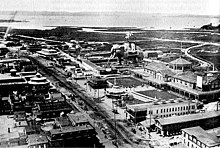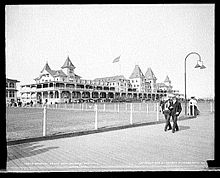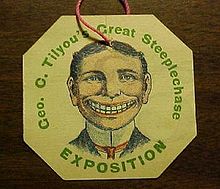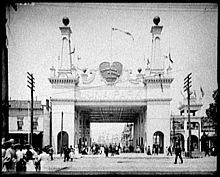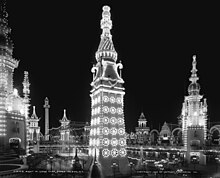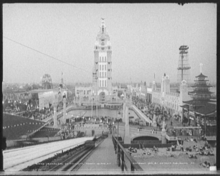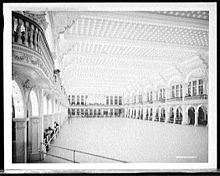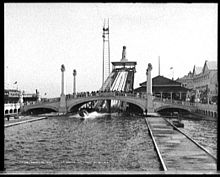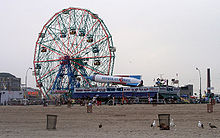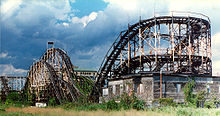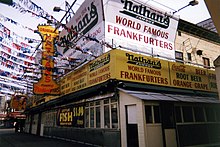Coney Island
| Coney Island | ||
 Coney Island satellite image |
||
| Geographical location | ||
|
|
||
| Coordinates | 40 ° 34 '33 " N , 73 ° 59' 53" W | |
| Waters 1 | Atlantic Ocean | |
| length | 8 kilometers | |
| width | 1 km | |
| surface | 8 km² | |
 Coney Island beach with the amusement parks and the skyscrapers behind |
||
The peninsula Coney Island ( English for Rabbit Island ) is the extreme southern tip of Brooklyn , which lies directly on the Atlantic coast and is best known for its large amusement parks and the adjacent high-rise housing estate of Russian immigrants. Originally, Coney Island was actually an island that stretched around eight kilometers in an east-west direction and was almost a kilometer wide. It was separated from Brooklyn by the Coney Island Creek , a good half of which was filled in in the 1940s to build the Shore Parkway urban highway.
The New York community of the same name (Neighborhood) only refers to the part of this island that lies between Ocean Parkway and 37th Street West and belongs to the 13th Brooklyn borough ( Community Board ) .
history
origin of the name
The name coney comes from Dutch and appears for the first time in 1639 on a map by Johannes Vingboon . When New York was still called Nieuw Amsterdam and the area belonged to the Dutch colony of Nieuw Nederland , it was known under the name Conyne Eylandt , which in today's language means Konijn Eiland , or "rabbit island ". The name actually comes from the large rabbit populations that populated Long Island at the time.
The first Europeans also settled here at that time. In 1643 the English lady Deborah Moody (1586-1659?) Settled here and founded Gravesend . This was one of the few colony foundations in North America by a woman.
After the British conquered the colony in 1664 and 1674, the name was transcribed into English, with coney actually being an outdated word for "rabbit". In 1690 the name Conney Isle appeared, in 1733 the still valid formulation Coney Island was used for the first time . In historiography , the name is sometimes mistakenly translated to Rabbit Island , ignorant of its origin . Although the origin of the name can be proven beyond doubt, there are numerous rumors to the contrary about its origin. English settlers are said to have given the island the name Cone Island ("island of cones") because of its hills . Others claim the name comes from an island of the same name off the coast of Ireland near the city of Sligo . Still others think that the term coney is derived from the people of the Konoh , who are said to have lived there in the past. In reality, the Nyack lived there . They sold that "sandbank" in 1654 to the European settlers.
The local Lenape , on the other hand , called the island Narrioch , "land without shade", because the sun shone all day long on the beaches in this area.
Summer retreat and entertainment district (from 1829)
In the 19th century, Coney Island became a seaside resort and vacation spot for wealthy American citizens who could afford to travel the 20 kilometers from New York for the summer vacation. In 1829 the first road connection with a bridge was built over the Coney Island Creek ; at the same time, the first hotel , the Coney Island House , opened, and more were added in the decades that followed.
But the island increasingly attracted politicians and business people who did their sometimes questionable business there, above all a certain Mike Norton , who had made a fortune with army equipment during the Civil War.
Little by little, less fine establishments were added. Above all, the new rich and businessmen built hotels in the west of the island with illustrious names such as “Windsor” , “Tivoli” or “Sea View” , which, however, were mainly used for gambling and prostitution . This milieu attracted criminals of all kinds. At the corner of Surf Avenue and 5th Street West stood the most famous such establishment, the Hotel Elephant by James V. Lafferty from 1885. The 100 feet (≈ 30 meters) long and 72 feet (≈ 22 meters) high building in the form of a Elephants quickly became a symbol of the “horizontal trade”, which was reflected in the expression “Seeing the Elephant”. To this day, the term "Coney Island Whitefish" has also been used in New York slang for used condoms.
The then responsible municipality of Gravesend with its 500 inhabitants was unable to do anything about it. Instead, under the leadership of the notorious Mayor John McKane , the idea came up to build such establishments themselves and to secure a share of the income by leasing them, which accelerated the development.
The prerequisite for this development was that a paddle steamer had been calling the island more or less regularly from Manhattan since 1846 : Since the crossing only cost 50 US cents, Coney Island was accessible to the middle class from then on. In 1865, Peter Tilyou built the Surf House ("House on the Surf"), the first lido with a bar for Bavarian beer. Other bathing establishments followed until the 1880s, such as the Manhattan Beach Bathing Pavilion ("Lido Manhattan Beach"), the Brighton Beach Bathing Pavilion ("Lido Brighton Beach"), the West Brighton Baths ("Badeanstalten West Brighton") and the Iron Pier Baths ("Lido on the Iron Pier").
After the west of Coney Island was increasingly populated by the middle class and other parts of it fell into disrepute as entertainment districts, the wealthy withdrew to the east of the island: in 1876, the Manhattan Beach Hotel and the Oriental Beach Hotel were built near Coney Island Avenue by August Corbin and two years later, a few hundred meters east of it, the Brighton Beach Hotel by William A. Engeman , both of which were at the time one of the grandest and noblest hotels in the United States. Since bathing in the sea had become fashionable among the upper class, these houses were heavily frequented.
Because the Brighton Beach Hotel was increasingly threatened by coastal erosion over the years , the 150-meter-long and 6000-tonne structure was undermined in the spring of 1888, lifted in one piece onto 120 railway wagons and moved almost 200 meters inland by six steam locomotives.
Construction of the railways (1867–1885)
In addition to the steamship line to Manhattan, the railway lines built in the 1860s and 1870s from what was then the southern outskirts of Brooklyn ensured a steadily growing flow of visitors. This increased even further with the opening of the Brooklyn Bridge in 1883 and the connection to the elevated railways of the Brooklyn Elevated Railroad (BER) six years later. Today the routes are largely part of the New York subway .
In 1867 the Brooklyn, Bath and Coney Island Railroad reached the island. The line, initially operated as a horse-drawn tram , ran from the corner of 25th Street and 5th Avenue , Brooklyn via New Utrecht Avenue and 86th Street to around the point where today's Coney Island – Stillwell Avenue station is located. The route essentially corresponds to today's BMT West End Line and is the oldest route on the New York subway.
1875 took Prospect Park and Coney Iceland Railroad of Andrew Culver between Prospect Park and the island to operate on; The terminus was Culver Terminal on the corner of Surf Avenue and 5th West Street . Today's BMT Culver Line ran along Gravesend Avenue , today's McDonald Avenue .
In 1878, the Brooklyn, Flatbush and Coney Island Railroad opened their tourist train from Prospect Park to the Brighton Beach Hotel . It corresponds to today's BMT Brighton Line .
In 1879 the Sea Beach and Coney Island Railroad could finally start operating. The terminus was about 10th Street West. The route is known today as the BMT Sea Beach Line .
In 1880 the New York and Brighton Beach Railway opened , which had to give up a month and a half after the start of operations. Attempts to save the railway failed.
In 1885 the New York and Manhattan Beach Railway finally started operations in cooperation with the Long Island Rail Road (LIRR). It ran from East New York and Battery Bay Ridge down to the Manhattan Beach Hotel . Since it did not run along the main traffic streams, it found itself increasingly remote from the action, so that it was shut down in 1924.
In contrast to his competitors, Culver built his railroad along the towns between Brooklyn and South Beach, so that it could operate cost-effectively all year round and the fare was only 35 US cents. In 1878 the line was expanded to two tracks. In addition to the terminus, the first “ordinary” hotels and the 90-meter-high iron tower with viewing platform and steam elevator, which he had acquired from the 1876 World's Fair in Philadelphia , were built under Culver's direction . His investments played a decisive role in the development towards later mass tourism.
The connection of the railroads to the Brooklyn Elevated Railroad in 1889, the New York subway in 1901 and the introduction of the single tariff of 5 US cents with the double contracts in 1913 made Coney Island definitive for the masses of the above all poor people available from all over New York. To cope with these crowds, the railroad lines were partially expanded to four tracks and in 1919 the new eight-track terminus was opened on Stillwell Avenue .
The Coney Island and Brooklyn Railroad connected a number of ferry docks on the southern outskirts of Brooklyn with Coney Island with their horse-drawn tram. The terminus was a little further away from the beach on Gravesend Avenue (now McDonald Avenue ). Since the route ran in the middle of Coney Island Avenue , it was converted to tram operation. Like all other Brooklyn streetcar routes, it was shut down in the 1950s. The route now serves the B68 bus line.
A pier was built for shipping in 1878 at 8th Street West , which was replaced by a larger structure as early as 1880, so that steamships could operate every 20 minutes during the high season. There were also new road connections, such as the Ocean Parkway built in 1876 . The more than 20 meter wide road ran from Prospect Park almost dead straight to the coast and was lined with avenue trees.
Horse races and first roller coasters
After the noble customers in the hotels in the east soon demanded entertainment, a total of three horse racing tracks were built between 1879 and 1886 . Coney Island became the capital of horse racing and horse racing. Another crowd puller arose for people looking for a quick buck, increasingly also from the lower classes. Around 1905, over 100 bookmakers catered for up to 40,000 visitors on a single race day. After horse betting was banned in 1908 under pressure from the church, the racetracks were closed until 1910. With the horse races, the wealthy disappeared from the area soon after, so that the upscale hotels in the east had to close in the years that followed.
But it was precisely the rush of less noble people that led to the construction of further establishments. The amusement arcades and seedy bars were joined by third-rate theaters, show stages and downright drinking miles, especially along Bowery Street and Surf Avenue between 6th and 16th West Street . Thus, the western part of the island was finally marked by alcohol, prostitution and gambling and the reputation of Coney Island as a seaside resort was ruined. For example, in 1917 Al Capone worked at the Harvard Inn , which was then owned by Frankie Yale . In 1931 Joe Masseria was shot dead in a restaurant there .
During this time, however, the first fairground rides were built, which at first mainly served the middle class for entertainment. Roller coasters, shooting galleries, circus tents and finally entire amusement parks soon lined the beach along the Atlantic coast. Many attractions arose from the remains of world exhibitions that had been bought together and taken to Coney Island. There were also dance halls like Stauch’s and excursion places like Feltman’s from Charles Feltman , the inventor of the hot dog, who started out with a sausage stand in 1867 and eventually became a restaurant with a beer garden and lido for several thousand people each.
The Nickel Empire of the interwar period
With the connection to the underground, the flow of visitors increased further, from an average of 100,000 visitors per day in 1900 to over a million in the same period of 1920. After 1913, due to the double contracts for a single journey, only a 5 cent -Piece, the famous " Nickel ", was needed, Coney Island got the nickname "The Nickel Empire" (German meaning "The five-cent empire"). Those strata of the population who now flocked to the Atlantic coast every week could afford the trip, but did not have the 10 cents for a hot dog at Feltman’s or even the 50 cents for a cabin in one of the many private beach baths. They brought their food from home and sunbathed on the then only public bathing beach, the Municipal Bath House , which, despite its 12,000 cubicles, was much too small for the crowd. Weegee's famous photographs of the crowded beach at Coney Island also date from this period .
In the Great Depression set in after 1929 deflation was so that the shooting their commitment and the value had to lower their profits a pressure on prices. Accordingly, there were no more household items, but food or a packet of coffee beans to be won. People like Nathan Handwerker ( Nathan’s ) with their simple sausage stalls now made the most money. Since profit margins were getting smaller and smaller, it hit those companies that were heavily dependent on the weather. Space rents and staff costs did not decrease, and so a few rainy weekends could push the annual balance into the red and force the operators to give up.
Since around 1893, a series of serious fires had also occurred. As one of the first attractions, the Hotel Elephant burned down in 1896 , three years later the first Stauch’s . In 1907 and 1911 an amusement park burned down completely. The combination of narrow streets, mostly wooden buildings and coastal winds were ideal conditions for the flames to spread quickly. In addition, the fire brigade made hardly any progress in the narrow streets. When the emergency services finally reached the scene, illegally tapped water pipes sometimes caused the water pressure to be too low.
In the end, the city council was forced to intervene: Surf Avenue and Bowery Street were widened in 1923 by demolishing around 175 restaurants and bars. The most famous victims were the Nathan’s and the Stauch’s , who, however, took a lot of effort to relocate their properties a few meters back true to the original. After another major fire in 1932, new hydrants and a high-pressure line were installed.
In the same year, to prevent coastal erosion, tree trunks were rammed into the ground along the coastline for a length of four kilometers between 37th Street West and Corbin Place , which will form the foundation for the new beach promenade, which is almost 25 meters (80 feet) wide Riegelmann Boardwalk , formed. Before that, tons of sand were dumped on the beach, which from then on was accessible along its entire length as a “public bathing beach” and finally had sufficient lifeguards.
Decline after World War II
During the Second World War , these attractions were still a welcome change, but in the wake of the economic recovery after the Great Depression, the operators of the fairground rides increasingly had to fight for their customers. Despite some new facilities like the Parachute Jump , the events failed to raise the level enough to keep them attractive given the changing way of life.
Since the 1950s, excursion destinations that could be easily reached by car have also enjoyed great popularity, which was not the case at all for Coney Island. One example is Jones Beach State Park on the south coast of Long Island. Poor families moved away from Brooklyn, preferred to go to the movies or have fun at home in front of the television.

Even before the last major facilities were closed, the city administration under Mayor John Lindsay tried to develop the area in a “different direction”, with the influential urban planner Robert Moses in charge. In place of the amusement parks, large blocks of flats were built in the 1960s, mainly for social housing , which today dominate the western part of the island. The construction of the New York Aquarium , which opened its doors on June 6, 1957 , also fell during this period .
But precisely because of the residents of those high-rise buildings, who came from poor backgrounds, the area changed rapidly, which from then on was characterized by unemployment, vandalism, lounging, mainly African-American young people and increased street crime. Headlines like this, when about 4,000 people fought a street battle with the police on May 31, 1966, gave further nourishment to that threatening backdrop. The increasingly bad reputation of the area caused more and more visitors to stay away, so that the amusement parks had to give up. Coney Island became a “ no-go area ”, some of which were even deliberately left to decay so that they could later be redesigned according to new ideas. After these plans were hardly implemented, the area around the former amusement parks is still lined with ruins and wasteland .
Change after the oil crisis
After the end of the big amusement parks, the oil crisis and the urban financial crisis in the mid-1970s, things have been slowly picking up again for some time. Some smaller complexes that have survived, such as Astroland , are now expanding a little again. The increasing intermingling of the population is also having a positive effect; Unemployment and crime have fallen at an above-average rate.
Since 1983 , the Amateur Mermaid Parade ("Amateur Mermaid Parade") has taken place on Mermaid Avenue every year at the end of June . She cites the Mardi Gras parades from the early 20th century. Together with the Siren Music Festival (" Siren Music Festival "), which has been taking place since 2001, in mid-July, two large folk festivals have now established themselves on Coney Island. In 2001, KeySpan Park was opened as a baseball stadium.
Overall, Coney Island today offers the image of an "ordinary" run-down New York suburb with apartment blocks and small single-family houses, various shopping centers and furniture stores along the city freeway - and an amusement park that rises between various ruins. There is also the boardwalk and the beach, which are still well-attended on hot summer days.
future plans
Since the turn of the millennium there have been increased efforts by officials to make Coney Island more attractive. The urban development company Coney Island Development Corporation , founded in 2003, aims to promote urban and cultural development in the area. The planned measures include the construction of a new district center in the western high-rise estate, the redesign of some streets as well as more upscale gastronomic and cultural offers on the beach beyond the hamburger stalls and shooting galleries. A pedestrian zone between the subway station and the beach and the closure of vacant lots should bring the area closer together. In Asser Levy Park , a new open-air theater is planned. A total of more than a billion US dollars is to be built.
In the long term, in contrast to Robert Moses' plans from the 1950s, Coney Island is to be developed into a kind of trendy district. The French Quarter in New Orleans, Greenwich Village and Venice Beach in Santa Monica serve as models . The amusement parks are expressly part of the concept. However, they will not remain in their current form.
The municipality Coney Iceland (The Coney Iceland Neighborhood)
(This section describes the part of Brooklyn's 13th borough known as the "Coney Island Neighborhood.")
location
The community (neighborhood) Coney Island is located on the southwest part of the island. It is bounded in the north by the Bay of Gravesend (Gravesend Bay) , the remaining part of the Coney Island Creek and the Shore Parkway city highway and extends thereby from Ocean Parkway to 37th Street West . The main streets are Neptune Avenue , Surf Avenue, and Stillwell Avenue . The neighboring communities are Seagate in the west, Brighton Beach in the east and Gravesend in the north. Politically, Coney Island forms together with Brighton Beach, Seagate and the western part of Gravesend the 13th Brooklyn Community District 13.
The eastern tip of the island, Manhattan Beach , on the other hand, belongs to the 15th Brooklyn District (Brooklyn Community District 15).
population
The community had a total of 18,425 households with 46,415 inhabitants in 2000 , of which 46% were white, 28.7% black, 3.9% Asian, 18.8% Hispanic and 2.6% other. The proportion of foreigners was 36.4% and unemployment was 13.4%. The average annual household income amounted to 21,728 US dollars , 33.1% of the population lived below the poverty line. However, the milieu in the individual areas is very different.
Slightly more than a third of the population lives in 30 blocks of flats between 18 and 24 stories high that rise between Ocean Parkway and West 12th Street and are mainly inhabited by Jewish immigrants from the former Soviet Union. Among them, unemployment is lowest at 5.7% and median income is highest at $ 29,080. The increasing influence of Russian families since the fall of the Iron Curtain has earned the area around Coney Island and Brighton Beach the nickname "Little Odessa" ("Little Odessa ").
About one kilometer further west, behind 20th Street West , there is another district with high-rise buildings, mostly social housing, which, in contrast, is dominated by poverty. Of the approximately 26,000 inhabitants, around half are black Africans and a good quarter are Hispanics. Their median income in 2000 was 14,873 US dollars, and over 45% live below the poverty line; unemployment was 20.5%.
traffic
The excellent connection to local public transport originates from the time of the "Nickel Empire" . Four of the railroad lines built in the 1870s are still served by the New York subway and all end at Coney Island – Stillwell Avenue station . Currently (2006) the following lines operate there:
-
 Norwood – 205. Street ↔ Coney Island – Stillwell Avenue on the BMT West End Line
Norwood – 205. Street ↔ Coney Island – Stillwell Avenue on the BMT West End Line
-
 Jamaica -179. Street ↔ Coney Island – Stillwell Avenue on the BMT Culver Line
Jamaica -179. Street ↔ Coney Island – Stillwell Avenue on the BMT Culver Line
-
 Astoria – Ditmars Boulevard ↔ Coney Island – Stillwell Avenue via the BMT Sea Beach Line
Astoria – Ditmars Boulevard ↔ Coney Island – Stillwell Avenue via the BMT Sea Beach Line
-
 57th Street – 7th Avenue ↔ Coney Island – Stillwell Avenue on the BMT Brighton Beach Line
57th Street – 7th Avenue ↔ Coney Island – Stillwell Avenue on the BMT Brighton Beach Line
Trains of the BMT Culver Line still stop at 8th Street West – New York Aquarium and Neptune Avenue , the BMT Brighton Line also serves 8th Street West and also the Ocean Parkway and Brighton Beach stations .
There are also a number of bus routes which, with the exception of the express buses x28 and x29 to Midtown Manhattan, only have local significance.
The Shore Parkway city freeway connects Coney Island to the freeway network around New York. It runs along the coastline of the mainland and from McDonald Avenue to the east on the filled-in bed of Coney Island Creek . There are exits on 17th West , Shell Road, and Ocean Parkway .
Amusement parks
By the Second World War, the largest connected amusement park in the world was built on the island of Coney Island, the creation of which is far before Hollywood or Disneyland and was only surpassed by the latter. Millions of visitors populated the island annually during the season between May and September. The "entry" was free and had to be paid for with the individual showmen who had their rides lined up like shops along the streets. In the course of time, however, several self-contained systems were created:
Sea Lion Park (1895-1902)
In 1895, Paul Boyton , the inventor of the swimsuit, bought a piece of land on Coney Island on the corner of Neptune Avenue and West 12th Street to build the world's first amusement park. It hosted a water circus with sea lions that Boyton swam with in his rubber suit. There was also the “Shoot-the-Chutes” wild water ride and the world's first roller coaster with looping , the “Loop the Loop”. Boyton failed to provide new attractions year after year, so the financial reserves were running out. During the rainy summer of 1902 he had to give up and rented the facility to Frederic Thompson and Elmer Dundy , who incorporated it into their lunapark .
Steeplechase Park (1897–1964)
In 1897 George Cornelius Tilyou followed with his Steeplechase Park , the main attractions of which were a ferris wheel and the eponymous mechanical horse race, which consisted of six parallel iron rails with rideable wooden horses. In 1902 Frederic Thompson and Elmer Dundy joined them with their “Journey to the Moon”, a boat-like spaceship with “ Batman ” wings that was housed in a kind of Venturer driving simulator . In contrast to its later competitors, Tilyou had rather less dignified rides with thrills such as the Teufelsrad ("The Human Roulette Wheel") to offer. There was no gastronomy in this area. A funny, grinning man's face , the Funny Face, was used as an advertising character throughout his life and was adapted to the prevailing taste in various ways.
On July 28, 1907, a carelessly thrown cigarette started a major fire in which a significant part of the park and a number of neighboring buildings were destroyed. A security guard noticed the fire in time, but operated the fire alarm incorrectly, so that the alarm did not go off until half an hour later.
The park was rebuilt just a year later. In addition to the ferris wheel, horse races and a ballroom, the centerpiece this time was an approximately 140 x 80 m steel hall, the Pavilion of Fun , used for weather protection . In addition to a curious selection of carousels, it housed various oddities such as a "sausage machine". In the course of time, car races, bumper cars , a roller coaster and a swimming pool were added to the outdoor area. The park was also known for the Tunnel of Love ("Tunnel of Love") and the Barrel of Love , the "love barrel ".
After overcoming the global economic crisis, a fire broke out on September 16, 1939, which destroyed the southwestern part of the outdoor area. As a result, the Parachute Jump , previously shown at the New York World's Fair , was built at this point in 1941 . This 80-meter-high steel tower roughly corresponded to a free-fall tower, but the passengers were pulled up in pairs by one belt each and then braked by parachutes in free fall, so that one had the feeling of jumping out of an airplane. However, almost 40 men were required for the twelve parachutes.
After the Second World War, a gradual decline began. Due to disputes within the Tilyou family, new attractions were long in coming, so that it soon looked "like in a museum". At the beginning of the 1960s, visitors increasingly came from the poorer milieu of the newly built high-rise estate next door; there was brawl and vandalism. In addition, the concessionaires treated their customers badly, left the rides forfeited, and accidents increased. Under the pressure of increasing crime, falling visitor numbers and new security requirements, Steeplechase was closed on September 20, 1964 and then sold to an investor. He in turn sold the rides and had the buildings torn down for fear of the monument office, but his planned housing project was no longer realized due to a lack of building permission. The Parachute Jump , on the other hand, has survived to this day after it turned out to be too expensive to demolish.
Since 2001, the land between is at the northeast corner Kensington Walk and 21st Street West of KeySpan Park . The rest is a mixture of parking lot and wasteland. Until the end of 2000, the Thunderbolt roller coaster, which was shut down in 1982, was still rusting on the site . In 2014, a new roller coaster, also called Thunderbolt , was built on part of the site .
The urban planning concept provides for the Parachute Pavilion to be built between the boardwalk and the stadium . This striking structure, together with the Steeplechase Plaza, will act as a kind of cultural center and will be a crowd puller. To the west of it, mixed housing developments and, in front of it, a larger hotel with a shopping arcade are planned. The Parachute Jump will remain as a landmark .
Lunapark (1903-1946)
In 1903 Frederic Thompson and Elmer Dundy left Steeplechase Park and opened their own amusement park, the Lunapark , with the "Journey to the Moon" as the main attraction . The plant was in the square Neptune Avenue , 8th Street West , Surf Avenue and 12th Street West . Most of the attractions were grouped around an artificially created lagoon city in the oriental architectural style , which was towered over by the 60 meter high Electric Tower (" Electric Tower "). The more than 1200 gables and turrets could be illuminated with 250,000 light bulbs in different colors. The "Journey to the Moon" was supplemented with some rides with the same or a similar concept. In addition, a fictional naval battle in front of New York miniature models was shown in the “War of the Worlds” . And a certain Dr. Courney led his invention infant before. The Lunapark was also known for its trained elephants.
In addition to the rides, there have been new large-scale productions over the years, some of which have been scaled down and operated mechanically or performed true to the original with real props and actors. These include the “War of the Worlds” as well as the “Great Train Robbery” with original railroad cars, the “Streets of Delhi” with their elephants or the gold rush in the “Days of '49”.
In the following years, Lunapark was rebuilt and expanded again and again to keep the public happy. So again and again new carousels, slides, performances and buildings appeared, the palette of which ranged from the singing flower garden to ostrich races and a "dry" variant from Rapid River to mini-subway. However, as soon as a ride was no longer viable, it was immediately removed from the program. Even the lagoon city disappeared in favor of arcades and Japanese gardens, which in turn had to give way to a replica of the Hanging Gardens of Babylon . The "Shoot-the-Chutes" and the "Electric Tower" were among the few attractions that lasted until the end.
When, after Dundy's sudden death in 1907, there was no financial expert in the company, the finances got out of hand, not least because of Thompson's cocky lifestyle; By 1912 this resulted in a mountain of debt of US $ 665,000. Eventually a group of investors took over the park. However, this turned out to be not very innovative with regard to new attractions , so that more and more visitors stayed away, not least in view of the competition from movies. Despite various efforts, bankruptcy was filed during the Great Depression in May 1933 and again in 1939.
In 1941 some exhibits from the New York World's Fair of 1939/40 were brought here, so that the park was officially nicknamed the "New York World's Fair 1941". However, when the USA entered the war in 1941 and the associated operating restrictions, these efforts were not really successful. On August 12, 1944, around two thirds of the complex was destroyed by a large fire, as a result of which the creditors sold the area to a real estate company, so that the Lunapark had to be abandoned.
In the years 1959–1961, the Luna Park Houses ("Lunapark Houses") were built on this site . These five residential high-rise buildings now form the backdrop for Astroland made of red brick .
Dreamland (1904-1911)
1904 was followed by William H. Reynolds ' Dreamland ("Dreamland"), which was south of Surf Avenue between 5th and 10th Street West. The former 8th Street West served as the main axis, in the place of which a 90 × 40 meter artificial lagoon was created, with its central 120 meter (375 feet) high electric beacon, the Beacon Tower and above, modeled on the Giralda of Seville one million lightbulbs put all competitors in the shade. The design was based on the structure of the world exhibitions of the time; Due to the lack of creativity on the part of the management, the attractions were based very much on those of the Lunapark , but the execution was more generous and was almost four times as expensive. You could not only advertise with larger rides, but also with a lower admission price and the direct connection from the Iron Pier from 1880 with steamboats to Manhattan. On this pier was the largest ballroom in the world at the time, at 2,300 square meters.
The attractions mainly consisted of small to medium-sized science fiction rides and various productions (“show events”) in which the audience was shown an almost perfect illusion for a few minutes either in small vehicles or sitting on a grandstand. For example, a 75 × 25 meter hall became a little Venice with St. Mark's Square and Grand Canal , in Lilliputia ("Lilliputanien") one could marvel at a true-to-scale replica of Nuremberg inhabited by dwarfs ; there was also Jules Verne's “ Journey to the Center of the Earth ”. Vesuvius erupted in another hall and buried a scaled-down Pompeii . The main attraction, however, was the large fire brigade stunt show “Fighting the Flames” . In front of 1,500 spectators, a large building was set on fire, which had to be extinguished by four fire engines with 120 men. In 1906 the arena was rebuilt, which from then on recreated the San Francisco earthquake just as realistically .
- Stunt show "Fighting the Flames"
Dreamland only got its first real roller coaster in 1911 with the Giant Racer , the largest roller coaster on Coney Island at the time.
On May 27, 1911, a fire broke out during repair work in the Hell Gate ghost train ("Gate to Hell"). Although the fire brigade was on the spot quickly, they could not prevent the flames from spreading because the hydrants did not provide the necessary pressure due to repair work on the water pipe. Except for the steel-built Giant Racer , the system burned down completely. After due underinsurance , the sum of land value and insurance sum equivalent to about the level of investments, the management decided to liquidation . This fire was the template for the historical novel Dreamland , written by Kevin Baker in 1999 .
Finally, a western show and a petting zoo were built on the western part of the site; the Giant Racer continued to operate until 1926. The eastern part of the area was sold to the City of New York, which first built a green area there and then, in 1957, the new New York Aquarium . To the west of it there is now a parking lot and the Cyclone roller coaster.
Astroland (1962–2008) / Dreamland (2009) / Lunapark (since 2010)
Astroland (or its successor) is the first of two of the remaining connected amusement parks on Coney Island. It is located south of Surf Avenue directly on the Riegelmann Boardwalk between 10th Street West and Jones Walk . The property had belonged to the Feltman family until the foreclosure sale in June 1954. The new owners, Dewey Albert and Herman Rapps , leased the restaurant, built a number of rides next to it and initially called the whole thing Wonderland ("Wonderland"). In 1962 the facility was renamed Astroland , and the main attractions known today were added under the motto "Journey to the 21st Century": the Cape Canaveral Satellite Jet , the "Gondolas to Mercury" ( Mercury Capsule Skyride) and two years later the 84 meter high panorama tower called Astrotower , the "Astroturm".
Although more and more visitors stayed away in the 1960s, Astroland was able to assert itself because it had new attractions on the one hand, and some bought-up attractions in the Steeplechase Park on the other. The fire in 1975, which among other things killed the former Feltman’s , also unintentionally created space for new, more modern rides, which could now be seen directly from Surf Avenue . The roller coaster Cyclone ("Zyklon") , built in 1927, was added, and the first modern high-speed carousels were added with a music express , a break dance and an enterprise . Overall, the facility with roller coaster, top spin , chain carousel, water slide and various children's carousels is sometimes more reminiscent of a folk festival.
At the end of 2006, the Albert family sold the plant to the Thor group of investors . According to the plans, Astroland should finally close at the end of the 2007 season and be dismantled except for the Cyclone. However, at least the 2008 season was secured for the Astroland, the 2008 opening of the Astroland will take place on March 16, 2008, the continuation beyond 2008 was already more than uncertain at that time. A new roller coaster with a length of 1200 meters, a fun pool, a hotel and apartments were to be built on the site. The total investment should be $ 1.5 billion. In 2009 the park opened for one season under the name Dreamland , and since 2010 it has operated as the Lunapark .
Deno's Wonder Wheel Amusement Park (since 1983)
Right next to the Astroland is the second amusement park, Deno's Wonderwheel Amusement Park . It is named after the Giant Ferris Wheel Wonder Wheel , which was built in 1920 by the Garms family based on a design by Charles Herman and, along with the Cyclone and Astrotower, is one of the widely visible attractions on Coney Island. It has been one of the official landmarks of New York City since 1989 .
The Wonder Wheel is 150 feet (almost 46 meters) high and has eight stationary cabins on an outer ring 135 feet (41 meters) in diameter and a smaller, concentric inner ring. Another 16 cabins are movably arranged on a rail between these two rings, so that these cabins, following the laws of gravity , abruptly slide back and forth between the two rings during each revolution of the wheel.
However, this amusement park's roots go back to another ride. In 1955, the Garms still built - as one of many - the Spook-A-Rama ("Spukorama") ghost train , which at the time was one of the longest and most modern of its kind and is still in operation today. Business was so successful that several more rides were added over time.
In 1983 the facilities were sold to the Vouderis family , who turned them into today's amusement park. They named their main attraction after the head of the family, Dennis . The layout is otherwise basically similar to the Astroland ; Today it offers bumper cars, various children's carousels and even a free fall tower, the Super Shot (“ Super Shot ”).
Other rides
The organized amusement parks together housed only about a quarter of the rides on Coney Island, so that there were a number of individually operated attractions of all stripes, especially along Surf Avenue and Bowery Street , some of which are still in operation today. These so-called “independent rides” included carousels, shooting galleries, snack stands, miniature railways and roller coasters as well as beer tents, restaurants, hotels, theaters, dance halls and, until the Riegelmann Boardwalk was built in 1923, the beach baths. The clientele consisted mainly of "walk-in customers"; many rides only existed for a few years. Either they were replaced by larger ones, or the showman could no longer pay the rent and had to give up.
A number of such stands still exist today. However, these are mostly shooting galleries, small rides and food stalls that are crowded around the Astroland and the Wonder Wheel .
Attractions
The type of amusement ride that prevailed at certain times was based on certain trends that changed over the years. This is due to technical progress, social development and the financial possibilities of the prevailing clientele.
Carousels
Unless they were inclined to horse racing, the representatives of the "finer" society of the late 19th century preferred slower carousels, the first of which was the Balmer’s , built in 1875 by Charles ID Looff . More were added by the turn of the century. After a second high phase during the “Nickel Empire”, after the Second World War, a number of carousels were taken to other New York parks over the years, where they are still in operation today. Today, Coney Island only has the B & B Merry-go-round from 1932.
The best known was the three-disc carousel El Dorado . It was built in 1907 by the “carousel king” Hugo Haase in Leipzig , sold to Coney Island in 1910 for US $ 150,000 and then stood in the Pavilion of Fun in Steeplechase Park. It survived its end and went to the 1970 World Exhibition in Osaka . Today it stands in Toshima-en amusement park in Tokyo's Nerima district . It is the oldest carousel in the world that is still in operation.
roller coaster

In later years there was more demand for thrills from visitors , which led to the development of roller coasters. On June 13, 1884, Marcus Thompson opened the world's first such construction with his famous Gravity Pleasure Switch Back Railway . To date, around 50 such systems of different sizes and speeds have been built, most of which disappeared after a few years. In the course of time, there have been numerous improvements in terms of the driving elements and safety equipment, so that the construction of technically sophisticated systems was possible as early as the 1920s. This is how the “famous three”, the Thunderbolt (“Donnerblitz”, 1925–1982), the Bobs (later: Tornado , 1926–1977) and the Cyclone (1927 – today) emerged, which are primarily distinguished by their size and construction Refinements distinguished. The Thunderbolt , designed by John Miller in 1925 , had a slope with a "heel" and the Cyclone a slope of 59 degrees , while the Tornado (bobs) had many steep turns due to its limited space .
After the tornado (Bobs) was badly damaged by fire in 1977, it was canceled the following year. The Thunderbolt operators gave up in 1982. Attempts to restart operations failed, so that the plant was left to decay for years. On November 17, 2000 the demolition followed. The Cyclone narrowly escaped this after being shut down in 1965. Nevertheless, it was successfully leased to Astroland in 1975 , where it is still in operation today. It has been a listed building since July 1991.
The automobile
In the first two decades of the 20th century, the automobile caught the attention of developers; they wanted to make this “rich man's toy” accessible to the common man. One of the first rides of this kind was in 1906 Neville's Automobile Railroad ("Nevilles Auto-Bahn"), on which the individual carriages were guided by a rail similar to the mechanical horse race. However, the development soon moved towards freely moving vehicles. At the Gadabout and the Dodge'em , they have been attached to a net-like overhead line since 1919 , as it is known today from bumper cars. Others were equipped with batteries and later with internal combustion engines, which led to the development of the go-kart track around 1930 . Both variants still exist on Coney Island today, but they are no longer special.
Curiosities
Not only were many of today's conventional rides invented or shown for the first time on Coney Island; some of the attractions made their breakthrough outside of any amusement park and are now commonplace items. In addition to Dr. Courney's infant incubators in the Lunapark, for example, a dispensing system in the shape of a "cow that never runs out of milk" or the first escalator that Jesse W. Reno installed on the Iron Pier in 1895. The “inclined elevator” , as he called it, consisted of a conveyor belt at an angle of 25 degrees with wooden panels mounted on it and a handrail that was still rigid at the time. He overcame a height difference of about 2.10 meters.
The curiosities of that time also included exotic animals such as lions , camels and elephants , as can be seen in the zoo today. But deformed people were also put on display. In the "Congress of the Greatest Living Curiosities" in Dreamland, for example, there were gigantic and dwarfed people and the "terribly fat" Lady Trixy with an alleged 311 kilos body weight. Half-woman Violetta alias Aloisia Wagner also became famous . She was born limb , but could dress herself and do her hair .
Crazy technical innovations and curiosities still exist these days. In contrast to the times of the Nickel Empire, however, they are mainly shown on television . Hollywood cinema now covers shows like the San Francisco earthquake with its action films .
Buildings
In addition to the skyscrapers and the remaining entertainment venues, there are a number of noteworthy buildings on Coney Island:
New York Aquarium
The new building of the New York Aquarium , which opened on June 6, 1957 and is located between Surf Avenue and the Riegelmann Boardwalk at 8th Street West , houses over 8,000 specimens of 350 different marine animal species on 5.5 hectares . It is also the home of the famous gay penguin couple Roy and Silo . The affiliated marine research center Osborn Laboratories of Marine Sciences (OLMS) deals with dolphins , sharks and corals , among other things .
KeySpan Park
The Brooklyn Cyclones from the New York Penn League ("New York and Pennsylvania League") play their home games in this KeySpan Park baseball stadium , which opened in 2001 on the site of Steeplechase Park . It has space for 7500 spectators. The regional energy supplier KeySpan Energy holds the naming rights . Occasionally the facility is also used for rock concerts .
Parachute jump
The Parachute Jump (dt. Parachute jump ) is a 80 meter high and 150-ton, painted red, steely parachute jump tower , which the Riegelmann Boardwalk next to the KeySpan Park is located. It is also called the " Eiffel Tower of Brooklyn" because of its steel frame construction . Its construction is derived from Russian training towers for paratroopers from the 1920s. It was originally shown at the 1939 New York World's Fair in Flushing Meadows Park and was then brought here by the operators of Steeplechase Park , where it operated as a ride until 1968. The tower has been one of New York's official landmarks since July 1977 and has also been a listed building since 1989 . In 2002 an extensive renovation began, during which the rust- attacked steel frame was partially dismantled and replaced. Since July 2006 it can be illuminated in several variations at night by a light installation by Leni Schwendinger .
Coney Island Stillwell Avenue Subway Station
The above-ground station Coney Island Stillwell Avenue, opened in 1919, is located at the corner of Stillwell Avenue and Surf Avenue and, with its eight platform tracks for four lines, is the largest subway station in the world in terms of area. Its generous concept goes back to the time of the "Nickel Empire". In the years 2001 to 2005, the increasingly dilapidated system was completely rebuilt and received a three-part arched roof on which a photovoltaic system with 2800 mirrors and a total area of over 5200 square meters with a total of 210 kWp is mounted. According to the manufacturer, this is "the world's largest building-integrated PV solar power system with thin-film modules". On the mezzanine floor, the artwork "My Coney Island Baby" by Robert Wilson shows some stylized motifs from Coney Island.
Nathan's Famous
Near the corner of Surf Avenue and Stillwell Avenue is still the original fast food restaurant of Nathan's chain, which the company's founder, Nathan Handwerker was opened in 1916 at that point. Since then, the “ Hot Dog Eating Contest ” has been held in this restaurant every year on July 4th, the aim of which is to eat as many hot dogs as possible within twelve minutes .
Coney Island underground depot
Just north of the city freeway is the Coney Island Complex , the main repair shop for the New York subway. It was created in 1926 by the Brooklyn-Manhattan Transit Corporation (BMT). The 30-acre site is south of Avenue X between McDonald Avenue and Stillwell Avenue . In addition to the halls for maintenance and repair, there is a total of a parking station with 63 tracks, a train washing facility and the central scrapyard . The system can be clearly seen on the satellite image as a gray-brown spot.
Coney Island Light
The lighthouse Coney Island Light was built in 1890 and stands on the west end of the island at Nortons Point, in a residential area of Sea Gate on Lower New York Bay . It marks the shoal of Gravesend Bay and the entrance to Upper New York Bay .
Entertainment and marketing
basketball
Coney Island is a center of New York streetball and is therefore known as the home of some of the top players. A few street ballers made it into the North American basketball league NBA , the most famous of them being Stephon Marbury of the New York Knicks and his cousin Sebastian Telfair of the Minnesota Timberwolves . Both were Coney Island streetball legends while at Abraham Lincoln High School . About Telfair's senior year of high school, the sports broadcaster ESPN shot the documentary Through the Fire ("Durch's Feuer"). The 1998 film Game of the Life by Spike Lee is about a similar, but fictitious, career at Lincoln High School.
Movie and TV
Coney Island also gained great fame in the world of film:
- In Alfred Hitchcock's comedy Mr. and Mrs. Smith (1941), Carole Lombard and Gene Raymond get stuck during a joint jump from the parachute jump due to a technical defect.
- Douglas Sirk's melodrama As long as there are people (1959) begins on Coney Island with a desperate mother ( Lana Turner ) looking for her daughter who has been lost in the crowd.
- Perhaps the most famous residents of Coney Island come from the 1979 cult film The Warriors by Walter Hill , which is about a street gang with that name.
- The main character Alvy Singer in Woody Allen's 1977 film The Urban Neurotic grows up under a roller coaster in Coney Island. There are also some nostalgic Coney Island scenes in Radio Days from 1987.
- In the German thriller Fleisch (1979) the main character ( Jutta Speidel ) wanders through the abandoned amusement parks of Coney Island while fleeing from organ dealers.
- The psychological thriller Angel Heart (1987) takes place partly on Coney Island.
- Also on Coney Iceland the film is Requiem for a Dream by Darren Aronofsky in 2000, which represents the social decline of drug addicts at the center.
- In Steven Spielberg's 2001 film AI - Artificial Intelligence , the robot boy David goes to the flooded ruins of Coney Island, where he finds the blue fairy he is looking for in the form of a wooden figure in a theme park.
- In 2002 the film A Boss to Fall in Love was released , in which the lawyer Lucy Kelson ( Sandra Bullock ) campaigns for the preservation of the old buildings in the New York borough of Coney Island.
- In the 2003 film The Core , the energy needed for a super weapon is diverted to Coney Island.
- Andrew Niccol's political satire Lord of War, published in 2005, takes place in Little Odessa on the beach of Coney Island in the 1980s.
- The drama Last Days of Coney Iceland by Ralph Bakshi tells the story of a New York cop who falls in love with a prostitute, and, to deal with shabbiness of a run-down light district. The strip was supposed to start in 2008, but the film production was stopped.
- In 2012, Will Smith traveled back in time to 1969 in the movie Men in Black 3 and went to Coney Island to stop Boris the Beast.
- In the first season of the television series Mr. Robot , the headquarters of the hacker group fsociety is located between the amusement parks on Coney Island.
- The film drama Wonder Wheel by Woody Allen , which premiered in October 2017 as the closing film of the New York Film Festival and was released in selected American cinemas on December 1, 2017, is set on Coney Island Beach in the 1950s, around the Steeplechase Park .
music
In addition, Coney Island has made it into a number of music tracks. An album by Lou Reed from 1976 is called Coney Island Baby . Tom Waits used the same title for a song on his 2002 album Blood Money . The photo album of Death Cab for Cutie 2001 includes a song called Coney Iceland , as well as Van Morrison's album Avalon Sunset of 1989. Aerosmith brought with her 1979 album Night in the Ruts entitled Bone to Bone (Coney Iceland Whitefish Boy) . Coney Island Whitefish is also a piece of music by Joan Jett . The title Coney Island Steeplechase also comes from the album Another View by the group Velvet Underground from 1984/85 .
The band The Drifters dedicated their own piece to the so-called Boardwalk of Coney Island in 1964: Under the Boardwalk describes a summer day on Coney Island with a description of the amusements of the time. The piece is one of the most frequently covered songs in pop music. a. from the Rolling Stones .
Coney Island is also mentioned in the song Sleep on the album Lift Yr. Skinny Fists Like Antennas to Heaven! by Godspeed You! Black Emperor from 2000, an old man reminding himself of times gone by. The piece of music Red Dragon Tattoo by Fountains of Wayne from the 1999 album Utopia Parkway is about a boy who gets a tattoo on Coney Island to impress a girl.
The indie - rock band Franz Ferdinand mentions the "Coney Iceland Rollercoaster" in the song Eleanor Put Your Boots Back On from their second album You Could Have It So Much Better from the year of 2005.
Hans Neleman recorded the video for the song Wünsch DIR was from the album Kauf MICH! For the German punk rock band Die Toten Hosen . at the amusement park on Coney Island.
David Bowie sang Coney Island in the song Slip Away on the album Heathen from 2002 : Sailing over Coney Island, twinkle, twinkle Uncle Floyd ...
Metal band Type O Negative also mentioned Coney Island in their songs "(We Were) Electrocute" and "Stay Out of My Dreams". "(...) Your cold eyes of Coney Island sand, Hair dyed the blood of a foolish man (...)", "(...) A coney island high - when i get inside, All i ask is please stay out of my dreams ( …) ”The cover of their compilation“ The Least Worst Of ”also showed a photo of the parachute jump.
Lana del Rey refers, among other things, in the opening line of her song Mermaid Motel : “Maybe we could go to Coney Island. Maybe I could sing the national anthem ”. She also describes herself in "Off to the Races" as "Queen of Coney Island".
Andrew Lloyd Webber's musical Love never dies is the sequel to Phantom of the Opera and is also set on Coney Island. In the story, the phantom owns the Phantasma amusement park. Various "circus freaks" are shown in this park.
Books and comics
Coney Island has also been the setting for a number of detective novels , for example in Jerry Cotton volume 658 The Beast of Coney Island or in Murder on Coney Island by Victoria Thompson . In 1979, in his book Delirious New York , Rem Koolhaas discovered the previously often maligned place for official architectural criticism and thus wrote the first manifesto of the emerging postmodernism .
Winsor McCay is said to have been inspired by Coney Island for the dream worlds in Little Nemo , the slumber land .
The fight between Batman and Joker in the third part of the comic - novel Batman - The Return of the Dark Knight takes place in the tunnel of love from.
The Berliner Reinhard Kleist was devoted to the demolition of the amusement park at Coney Iceland in comic Steeplechase (2001). In 2007 he published the comic book The Secrets Of Coney Island with three short stories.
photography
Countless photographers have visited Coney Island and published pictures of the peninsula, including Henri Cartier-Bresson , Raymond Depardon , Elliott Erwitt , Jean Gaumy , Thomas Hoepker , Constantine Manos , Martin Parr , Ferdinando Scianna , Alex Webb and Weegee .
Bruce Gilden created an extensive photographic portrait of the beaches and amusement parks of Coney Island , which was published in the photo book of the same name.
Several photographs in the band Brooklyn transition from Bruce Davidson originated on Coney Iceland.
Promotional items
In addition to the usual gift items such as printed T-shirts, mugs, posters, mouse pads, fridge magnets and postcards, light switch panels, wall tiles, wristwatches and table clocks are also sold. The motifs are mostly the parachute jump, the Riegelmann Boardwalk at dusk, the Coney Island Freak Show , the Steeplechase Jack or the Cyclone roller coaster.
Others
The name Coney Island has also found its way into articles outside the advertising industry. For example, there is a nail polish in the shade of Coney Island Cotton Candy available from OPI , and with the Coney Island Mustard from Beaver Brand there is a type of mustard with the name of the island. Both products have only the name in common with Coney Island.
The tunnel of love from Steeplechase Park can be found as kitsch in the adventure game Sam & Max Hit the Road by LucasArts from 1993.
Many successful Coney Island entrepreneurs were unfamiliar. George C. Tilyou was a real estate agent , Paul Boyton was a captain , and an electrician and dentist built the most famous roller coasters. George C. Tilyou was a diligent churchgoer. In view of his new type of weatherproof hall, the Pavilion of Fun , his competitors blasphemed that he would only go there to pray for rainy weather . Nathan Handwerker, however, previously ran a thriving eatery in Manhattan . He went, he said, to Coney Island out of sheer boredom. He first signed on with his future competitor Feltman’s . When he opened his sausage stand, he also recruited a few extras to simulate the hustle and bustle of his restaurant.
The oldest ice swimming club in the United States, the Coney Island Polar Bear Club , was founded here in 1903.
Coney Island gave its name to the Leipzig youth club Conne Island, which was founded in 1991 .
Quote
"If Paris is France, then Coney Island, between June and September, is the World."
"If Paris is France, then from June to September Coney Island is the whole world."
Individual evidence
- ^ Joan Vinckeboons (Johannes Vingboon): Manatvs located op de Noot Riuier. 1639. Coney Island is called "Conyne Eylandt". Vinckeboons' card in the Library of Congress.
- ^ Robert Morden: A Map of ye English Empire in the Continent of America. 1690. Coney Island is called "Conney Isle". Murder's card on SUNY Stony Brook. ( Memento of the original from April 20, 2006 in the Internet Archive ) Info: The archive link was inserted automatically and has not yet been checked. Please check the original and archive link according to the instructions and then remove this notice.
- ^ Henry Popple: A Map of the British Empire in America . Sheet 12, 1733. Coney Island is called "Coney Island". Popple's map in David Rumsey Map Collection .
- ^ John H. Eddy: Map Of The Country Thirty Miles Round the City of New York . 1811. Coney Island is called "Coney I." Eddy's map in David Rumsey Map Collection .
- ↑ Weegee's famous photograph of the crowded Coney Island beach
- ↑ The Coney Island Cyclone on History House Photos.
- ↑ a b master plan of the Coney Island Development Corporation (PDF; 3.9 MByte)
- ↑ See also data on the 13th Brooklyn borough from the city council .
- Jump up ↑ See Brooklyn borough data from the city council . Census Tracts 326, 328, 330, 340, 342, 348.01, 348.02, 350, 352, 354 and 356.
- Jump up ↑ See Brooklyn borough data from the city council . Census Tracts 350, 354 and 356.
- Jump up ↑ See Brooklyn borough data from the city council . Census Tracts 326, 328, 330, 340 and 342.
- ↑ Architectural competition Parachute Pavilion Competition .
- ↑ Coney Island's Astroland Sold, Will Close Next Year on bloomberg.com
- ↑ Birthday greetings for the 50th anniversary
- ↑ See History of the Escalator .
- ↑ The Inventors: Jesse Reno on: The Museum for the Preservation of Elevation History (July 31, 2006)
- ^ Rise and rise of city's tallest building . on Worldwide Developments.
- ↑ Press release of Schott AG
- ↑ The artwork in the Coney Island Stillwell Avenue subway station on nycsubway.org
- ↑ Strictly speaking, the facility is not located on the island, but it bears its name and is also associated with it. For details see nycsubway.org .
literature
- John S. Berman: Coney Island. Portraits of America. The Museum of the City of New York. Barnes & Noble, New York 2003. ISBN 0-7607-3887-4
- Brian J. Cudahy: How We Got to Coney Island - the development of mass transportation in Brooklyn and Kings County. Fordham University Press, New York 2002. ISBN 0-8232-2209-8
- Charles Denson: Coney Island, Lost and Found. Ten Speed Press, Berkeley 2002. ISBN 1-58008-455-9
- Peter Granser: Peter Granser. Coney Island. Hatje Cantz, Ostfildern 2006. ISBN 3-7757-1776-5
- Robert J. Howe (Ed.): Coney Island Wonder Stories. Wildside Press, Rockville 2005. ISBN 1-55742-349-0
- Michael Immerso: Coney Island. The People's Playground. Rutgers University Press, New Brunswick 2002. ISBN 0-8135-3138-1
- John F. Kasson: Amusing the Million. Coney Island at the Turn of the Century. American Century. Hill & Wang, New York 1978. ISBN 0-8090-0133-0
- Rem Koolhaas: Delirious New York. Thames & Hudson, London 1979. ISBN 0-500-34078-1
- M Edo cCullough, Brian J. Cudahy: Good Old Coney Island. Fordham University Press, New York 2000. ISBN 0-8232-1997-6 (Edo McCullough is the nephew of George Cornelius Tilyou )
- Woody Register: The Kid of Coney Island. Fred Thompson and the Rise of American Amusements. Oxford University Press, Oxford 2003. ISBN 0-19-516732-5
- Harvey Stein: Coney Island. WW Norton & Company , New York 1998. ISBN 0-393-31787-0 (illustrated book)
Web links
- Goodbye to Old Coney Island @ nytimes.com - About the change in Coney Islands
Official websites
- Coney Iceland Beach & Boardwalk , New York City Department of Parks and Recreation (English)
- MTA website - Metropolitan Transportation Authority website
- The Coney Iceland History Project (English)
- American Experience | Coney Island - Documentation about Coney Island in the American Experience program by the Public Broadcasting Service (English)
- New Netherland Project / Institute - funded by the New York State Library and the New York Holland Society, the project has been devoted to the publication of sources on the history of the Nieuw Nederlands (English) since 1974
Unofficial sites
- coneyislandusa.com , a citizens' initiative
- The Coney Island Pages on the history of Coney Island ( Memento April 7, 2010 in the Internet Archive )
- Early Rapid Transit in Brooklyn, 1878 to 1913 - Railways in Brooklyn on nycsubway.org (English)
- Captain Bob's Home Page - Contemporary Views of Coney Island
- Forgotten New York - Extensive website with remnants from New York's past
- Pictures of Coney Iceland (English) ( Memento of 6 January 2009 at the Internet Archive )

